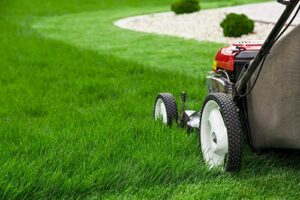June is a pivotal month for lawn care in Georgia. With the warmth of summer settling in and the growing season in full swing, it’s crucial to maintain a healthy lawn that can withstand the heat and remain vibrant. Stone Creek Landscaping is here to guide you through the essential steps for maintaining your lawn this June, ensuring it stays lush, green, and resilient.
Understanding Georgia’s Climate in June
Georgia’s climate in June is characterized by high temperatures, increased humidity, and occasional thunderstorms. These conditions create both opportunities and challenges for lawn maintenance. Understanding the local climate is the first step in developing a tailored lawn care strategy that meets the specific needs of your grass and landscape.
Mowing: Keep It High and Regular
Mowing is a fundamental aspect of lawn care. During June, it’s important to:
- Mow at the Right Height: Adjust your mower to cut at a higher setting. For most grass types in Georgia, a height of 2.5 to 3 inches is ideal. This helps shade the soil, retain moisture, and reduce the stress on your grass during hot days.
- Mow Regularly: Aim to mow your lawn once a week. Regular mowing prevents the grass from becoming too tall and reduces the likelihood of thatch buildup. Avoid cutting more than one-third of the grass blade length at a time to minimize stress on the plants.
- Keep Blades Sharp: Ensure your mower blades are sharp. Dull blades can tear the grass, making it more susceptible to disease and pests.
Watering: Deep and Infrequent
Watering correctly is crucial for maintaining a healthy lawn in the summer heat:
- Water Early: Water your lawn early in the morning, between 4 AM and 10 AM. This allows the grass to absorb moisture before the heat of the day and reduces evaporation.
- Deep Watering: Water deeply and infrequently, providing about 1 to 1.5 inches of water per week. This encourages deep root growth, making your lawn more drought-resistant.
- Use Sprinklers Wisely: Ensure your sprinkler system is functioning correctly and adjust it to avoid overwatering or underwatering specific areas.
Fertilizing: Give Your Lawn the Nutrients It Needs
June is a great time to fertilize your lawn to promote healthy growth:
- Choose the Right Fertilizer: Use a slow-release, high-nitrogen fertilizer suitable for your grass type. This provides a steady supply of nutrients throughout the growing season.
- Follow Application Guidelines: Apply fertilizer according to the manufacturer’s instructions to avoid over-fertilization, which can harm your lawn and the environment.
- Supplement with Organic Matter: Consider using compost or organic matter to improve soil health and structure.
Weed Control: Stay Ahead of Unwanted Invaders
Weeds can quickly overtake a lawn if not properly managed:
- Pre-Emergent Herbicides: If you haven’t applied a pre-emergent herbicide in early spring, it’s not too late. These herbicides prevent weed seeds from germinating.
- Post-Emergent Herbicides: Use post-emergent herbicides to target any existing weeds. Be sure to choose products that are safe for your specific grass type.
- Manual Removal: Regularly inspect your lawn and remove weeds by hand to prevent them from spreading.

Pest Control: Protect Your Lawn from Damage
Pests such as grubs and insects can cause significant damage to your lawn:
- Monitor for Pests: Regularly check for signs of pest activity, such as brown patches, chewed grass blades, or visible insects.
- Use Integrated Pest Management (IPM): Employ a combination of biological, cultural, and chemical controls to manage pests effectively. This includes encouraging beneficial insects that prey on lawn pests.
- Apply Insecticides When Needed: If an infestation is severe, use appropriate insecticides following the manufacturer’s guidelines and consider consulting a professional for safe application.
Aeration and Overseeding: Strengthen Your Lawn
June is also a good time to aerate and overseed your lawn:
- Aeration: Aerate compacted soil to improve water, nutrient, and air penetration. This promotes healthier root growth and overall lawn resilience.
- Overseeding: Overseed thin or bare spots to thicken your lawn and outcompete weeds. Choose grass seed that is suitable for Georgia’s climate and your specific lawn conditions.
Maintaining a healthy lawn in Georgia during June requires a comprehensive approach that addresses mowing, watering, fertilizing, weed control, pest management, and soil care. By following these tips from Stone Creek Landscaping, you can ensure your lawn stays lush, green, and vibrant throughout the summer. A well-maintained lawn not only enhances the beauty of your home but also provides a safe and enjoyable space for outdoor activities.
If you need professional assistance with your lawn care, don’t hesitate to contact Stone Creek Landscaping. Our team of experts is here to help you achieve the lawn of your dreams. Happy gardening!
